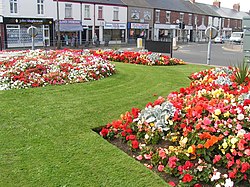Seaton Delaval
| Seaton Delaval | |
| Northumberland | |
|---|---|
 Seaton Delaval | |
| Location | |
| Grid reference: | NZ302749 |
| Location: | 55°4’57"N, 1°28’40"W |
| Data | |
| Population: | 4,371 (2001) |
| Post town: | Whitley Bay |
| Postcode: | NE25 |
| Dialling code: | 0191 |
| Local Government | |
| Council: | Northumberland |
| Parliamentary constituency: |
Blyth Valley |
Seaton Delaval is an old mining village in south-eastern Northumberland. It is the largest of the five villages in Seaton Valley and is the site of Seaton Delaval Hall, the masterpiece completed by Sir John Vanbrugh in 1727.
The name 'Seaton' is from the Old English Sætun, simply meaning 'sea village' from its standing close to the sea coast: its harbour village on the coast itself is Seaton Sluice. The suffix 'Delaval' is from its manorial ownership by the Delaval family. The name 'Seaton Delaval' was first attested as 'Seton de la Val' in 1270.
History
The manor and a broad estate hereabouts was held by the Delaval family, who took their name from Laval in Maine in France. Their descendants are still major landholders in the area today, and the current Lord Hastings has the first name Delaval: he is Delaval Astley, 23rd Baron Hastings.
Amongst the family born in this village, Ralph Delaval and George Delaval served as Admirals in the Royal Navy and the latter built Seaton Delaval Hall.
The rather threatening folk song "Blackleg Miner" mentions the village:
Oh, Delaval is a terrible place
They rub wet clay in the blackleg's face.
And around the heaps they run a foot race,
To catch the blackleg miner!
So dinna gan near the Seghill mine.
Across the way they stretch a line,
To catch the throat and break the spine
Of the dirty blackleg miner!
Geography
The village is centred on the intersection of two main roads: the A192 road running from North Shields to Morpeth and the A190 road running from the Dudley village bypass to Seaton Sluice. These main roads are lined by terraced housing from the turn of the 20th Century, but large post-war and 1970s house development is predominant. There are small pockets of more recent housing and as of August 2012, a new estate of houses is being completed.
Nearby villages include Holywell, Seghill, Seaton Sluice and New Hartley.
Churches
Churches in the village include:
- Church of England
- St Mary
- Holy Trinity, Seghill
- United Reformed and Methodist Churches: Elsdon Avenue Church
Economy
The village has its own independent cooperative, the Seaton Valley Co-Operative Society, which runs a small supermarket, post office and off-licence. There are also several convenience stores and public houses, such as The Keel Row pub/restaurant on Foreman's Row. The other, mainly independent stores include an ice cream parlour, pine furnishing store, florist and garage.
Procter & Gamble has a factory in the village, once the independent Shultons factory. Shultons formerly manufactured Old Spice aftershave before Procter & Gamble's acquisition of the brand. The factory is now employed in the manufacture of Clairol hair dye products, including Nice 'n Easy, as well as the Hugo Boss fragrance range.
Landmarks
Seaton Delaval Hall, recently taken into the care of the National Trust, is situated around half a mile east of the village off the A190.
Culture
The Seaton Delaval Arts Centre, a small auditorium hosting musical and drama entertainment, often locally produced, is housed in the former Salvation Army Hall in the centre of the village.
Outside links
- SeatonDelaval.org
- Arts centre - A Community Arts Venue
- Seaton Delaval History
- Residents' Association
- Astley High School
- The Keel Row, Pub & Dining
- Northumberland Communities: Seaton Delaval